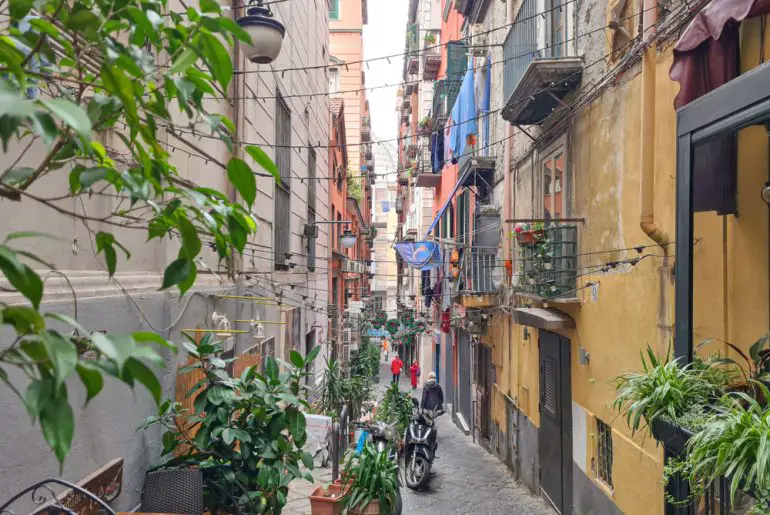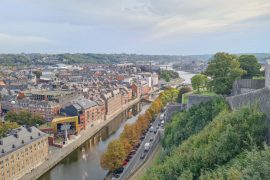Last Updated on 25.02.2024 by Iliyan
If you are planning your first visit to Naples, this Naples Itinerary in 2 days is perfect for you. With 2 days in Naples Itinerary, you have enough time to see all the main sights of the city. Naples is one of the most beautiful cities in Italy, located in the south of the country. It lies in the Gulf of Naples and it is dominated by the Mount Vesuvius. The city was founded by Greeks in the first millennium BC, and is one of the oldest continuously inhabited urban areas in the world. Naples is charming, chaotic, authentic, colourful, and budget-friendly. Also, it is known for being the birthplace of pizza and you’ll get some of the best on the planet while visiting Naples. Many people say Rome is Italy’s beating heart, Naples is its soul. However, get the full details on how to spend a perfect 2 days in Naples Itinerary.
Contents
- 1 How to get from Naples Airport to city center?
- 2 How to get around Naples?
- 3 2 days in Naples Itinerary
- 3.1 Historic Centre of Naples (Centro storico di Napoli)
- 3.2 Via San Gregorio Armeno
- 3.3 Naples Cathedral (Duomo di Napoli)
- 3.4 Sansevero Chapel Museum (Museo Cappella Sansevero)
- 3.5 Church of San Domenico Maggiore (Chiesa di San Domenico Maggiore)
- 3.6 Church of Gesù Nuovo (Chiesa di Gesù Nuovo)
- 3.7 Santa Chiara Monastery Complex (Complesso Monumentale di Santa Chiara)
- 3.8 Castel Nuovo (Maschio Angioino)
- 3.9 Galleria Umberto I
- 3.10 San Carlo Theatre (Teatro di San Carlo)
- 3.11 Gran Caffè Gambrinus
- 3.12 Piazza del Plebiscito
- 3.13 Royal Palace of Naples (Palazzo Reale di Napoli)
- 3.14 Basilica of San Francesco di Paola
- 3.15 Castel dell’Ovo
- 3.16 Stroll along Lungomare Caracciolo
- 3.17 Fontana del Gigante
- 3.18 Via Toledo
- 3.19 Toledo Metro Station
- 3.20 Quartieri Spagnoli
- 3.21 Castle Sant’Elmo (Castel Sant’Elmo)
- 3.22 Naples National Archaeological Museum
- 3.23 Catacombs of San Gennaro (Catacombe di San Gennaro)
- 3.24 National Museum of Capodimonte (Museo di Capodimonte)
- 3.25 Naples Underground (Napoli Sotterranea)
- 3.26 Pompeii Archeological Site (Parco Archeologico di Pompei)
- 3.27 Herculaneum
- 3.28 Climbing Mount Vesuvius (Vesuvio)
- 4 Where and what to eat in Naples?
- 5 Where to stay in Naples?
- 6 Cheap flight tickets to Naples
- 7 Best time to visit Naples
- 8 How many days to stay in Naples?
- 9 Is Naples safe for tourists?
- 10 Is Naples worth visiting?
How to get from Naples Airport to city center?
Naples-Capodichino International Airport (IATA: NAP) is located around 5 kilometers from the city center. There are several options to get from Naples Airport to city center including bus service, taxi and private airport transfer. The most popular way to get to the city center is by shuttle bus, called Alibus. It is running every 20-30 minutes starting at 5:30 am until midnight. You can get off at the Piazza Garibaldi where the train station is situated, or continue riding the bus down to the Port Immacolatella – Porta di Massa and Beverello – Angioino. A one-way ticket costs €5. You can purchase your tickets directly from the bus driver or you can book online on Alibus website. The bus station is located at 50 meters from the entrance to the airport. Note that the ticket is only valid for 90 minutes after validate it. The travel time from the airport to the train station is 15-20 minutes and about 30-35 minutes to the port.
If you want a cheaper solution, there is a municipal bus stop, called Maddalena – Aeropoto Civile, located at Viale Comandante Umberto Maddalena Str., a 10 minutes walk from Capodichino. After leaving the airport building move straight to the first roundabout, turn right and walk along the fence to Viale Comandante Umberto Maddalena Street. Cross the street and you will see the bus stop slightly to the left. Take a bus № 182 which runs to Piazza Dante.
The ticket price is just €1,30, but note that you can’t buy it from the driver. It can be purchased at the Sun Store tobacco in the airport. Tickets need to be validated when get on the bus.
Taxis are available from Naples airport in front of arrivals entrance. The cost from the airport to the city center is €18-20, while to the port is €20-22. The journey usually takes 10-15 min., depending on the traffic.
How to get around Naples?
Most of the tourist attractions in Naples are located within the historic center (Centro Storico), which is very compact and can be explored on foot. There are a few landmarks that will require you to take public transport to reach. The best way to reach them is by metro or funiculars, but you can also take a tram or bus.
2 days in Naples Itinerary
Naples is one of the most underrated cities in Italy and often tourists even miss it, going directly to the popular Sorrento, Positano, Amalfi and Capri. However, with only 2 days in Naples itinerary you will want to make the most of it. So keep reading about the best places to visit in this 2 days in Naples Itinerary.
Historic Centre of Naples (Centro storico di Napoli)
Start your 2 days Naples itinerary exploring the historic centre of Naples, dating back to 470 BC. It is a UNESCO World Heritage Site and one of the largest and authentic old towns in Europe. The historic center is delimited by Via Toledo – Via Pessina (west), Corso Umberto (south), Via Carbonara (east) and Piazza Cavour – via Foria (north). The old centre of Naples is home to some of the most important historical monuments, palaces, churches, and also iconic streets of Via dei Tribunali and Spacanаpoli.
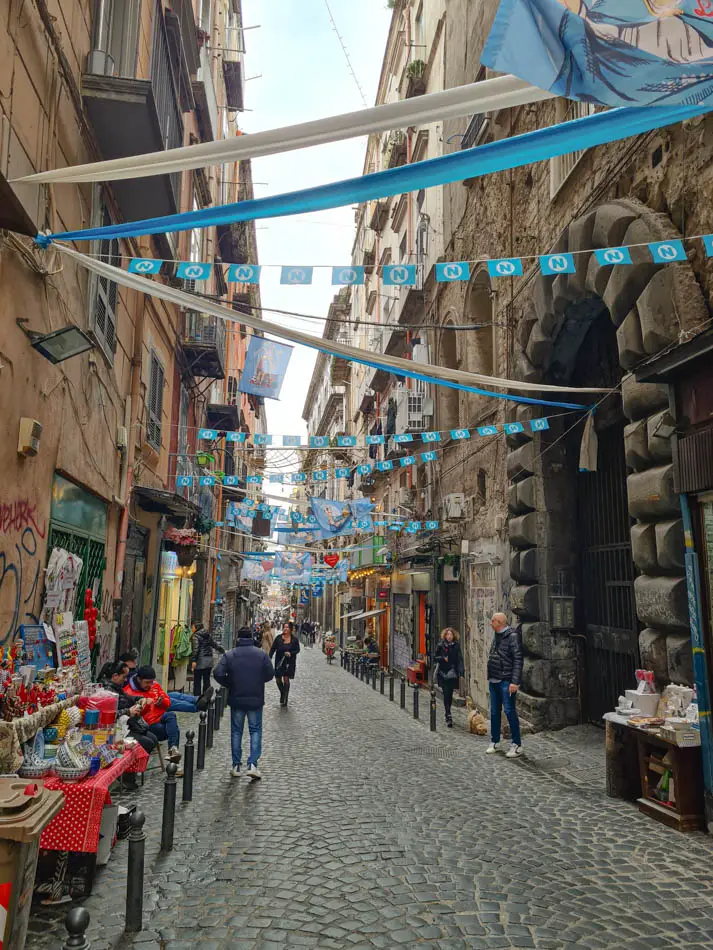
Spaccanapoli is very narrow street and cuts the old town into two parts. It is about 2 kilometres in length and includes many historical buildings, shops, restaurants, churches and more.
Via San Gregorio Armeno
Via San Gregorio Armeno is one of the most visited streets in Naples, known as Christmas Alley. It is a pedestrian street, located in the historic centre in Naples between Via dei Tribunali and Spaccanapoli.
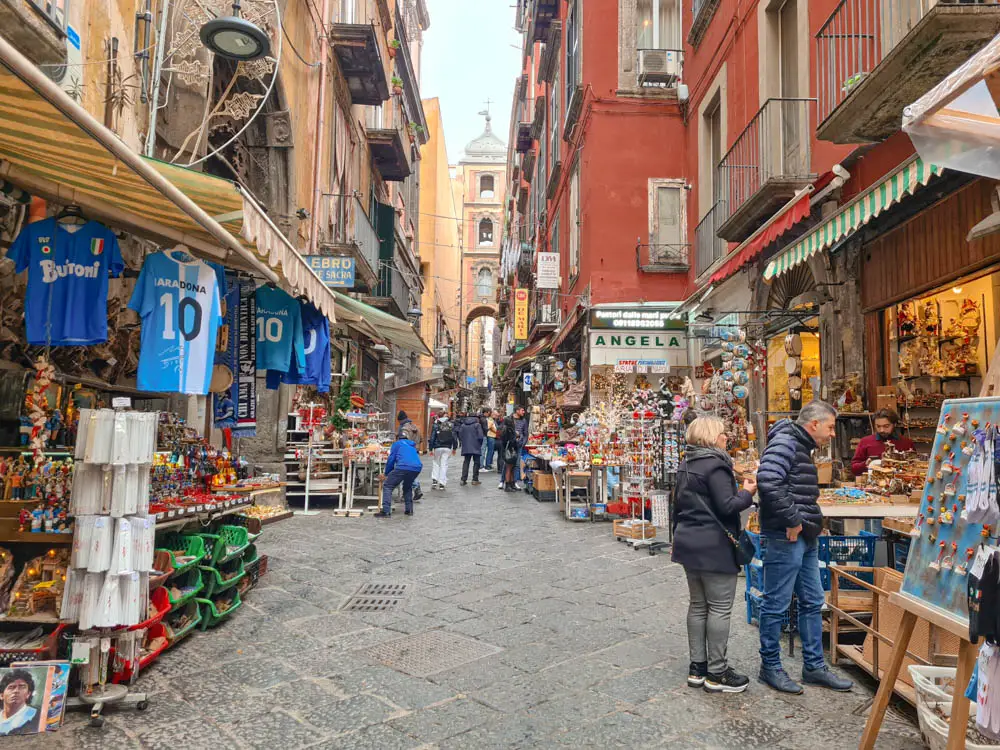
Via San Gregorio Armeno is home to artisan workshops and hundreds of nativity scenes, known as presepe. Here you will find all kinds of Christmas figures, football figures especially the Napoli team, and figures of famous people, politicians, actors, and even of the Pope. However, this street is an unmissable place in Naples, where you can buy any kind of Napolitanean souvenirs. I highly recommend wondering around Via San Gregorio Armeno.
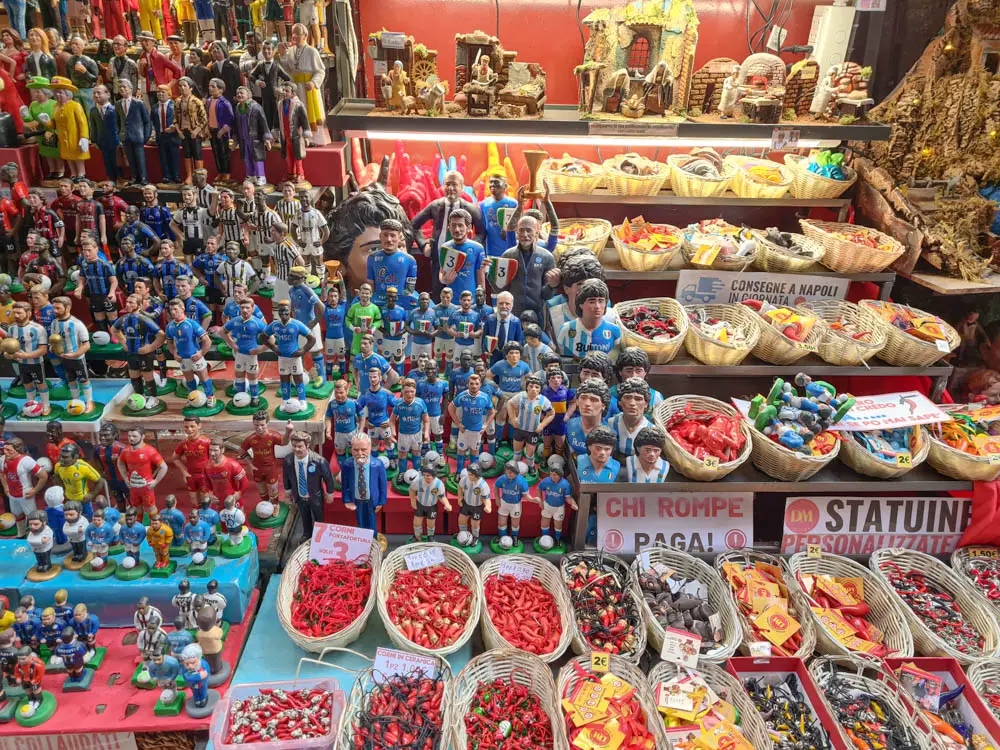
Just a few minutes walking from Via San Gregorio Armeno is located a very special place for football fans – Bar Nilo, a small coffee shop with an altar to Diego Maradona.
Naples Cathedral (Duomo di Napoli)
Duomo di Napoli is one of the most important religious sites you should to add to your 2 days Naples itinerary. The official name of the church is Cathedral of the Assumption of Mary (Cattedrale di Santa Maria Assunta), but it is simply known as the Cattedrale di San Gennaro.
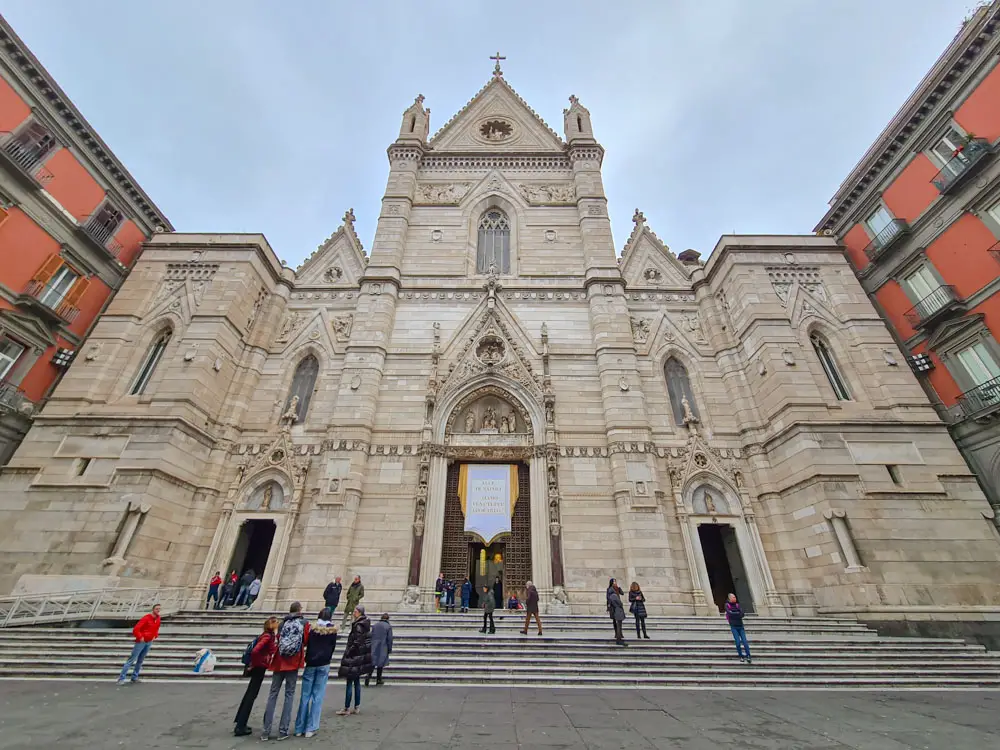
This magnificent structure was built in the 13th century and it is located in the heart of Naples on the Via Duomo. Inside is beautifully decorated with spectacular high altar, a truly masterpiece. There’s a crypt with relics of San Gennaro, the patron of Naples. There are two side-chapels – on the left side is the Chapel of Santa Restituta, which stands on the original palaeochristian church. On the right side is the chapel of San Gennaro, that features a finely decorated altar.
Sansevero Chapel Museum (Museo Cappella Sansevero)
Sansevero Chapel Museum is a quite small museum, located at the historic heart of Naples. The museum is home to the famous statue of the Veiled Christ (Cristo Velato) created by Giuseppe Sanmartino. The sculpture is an awe-inspiring piece of art of the finest craftsmanship. It depicts Jesus Christ, lying on a piece of marble and wrapped in a veil. The chapel has other mind-blowing sculptures worth seeing, but the main attraction is the Veiled Christ.
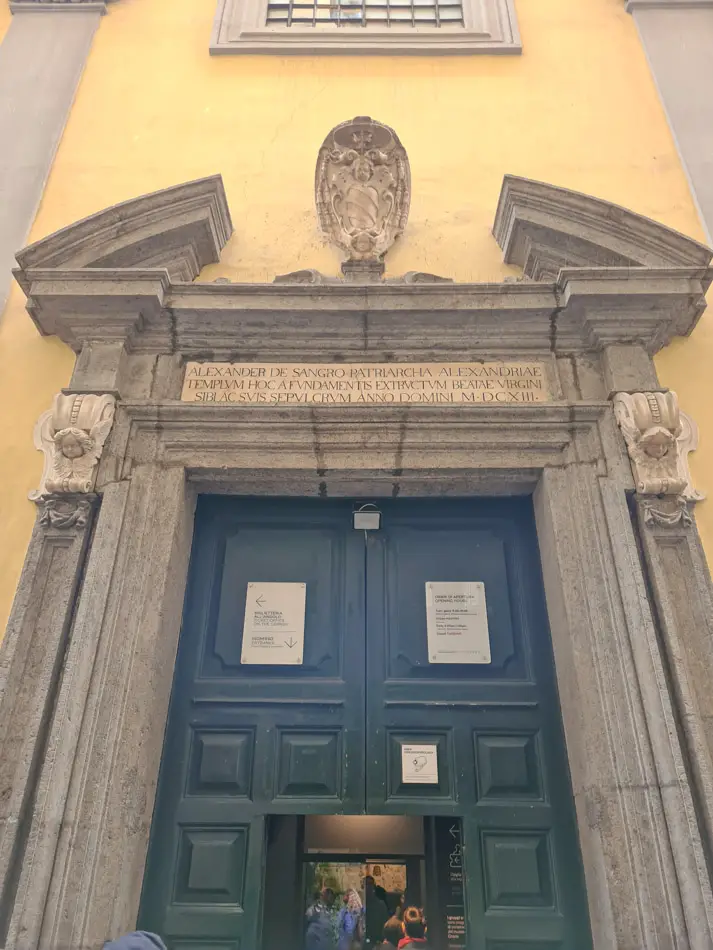
I would recommend getting the audio guide to understand the historical and religious context to the works of art. Note that the museum is one of the most visited sites in Naples and it is recommended to book tickets in advance here.
Church of San Domenico Maggiore (Chiesa di San Domenico Maggiore)
The Church of San Domenico Maggiore is a Gothic, Roman Catholic church and monastery, founded in 1324 by the friars of the Dominican Order. It is located in the historic centre of the old town of Naples in the square of the same name.
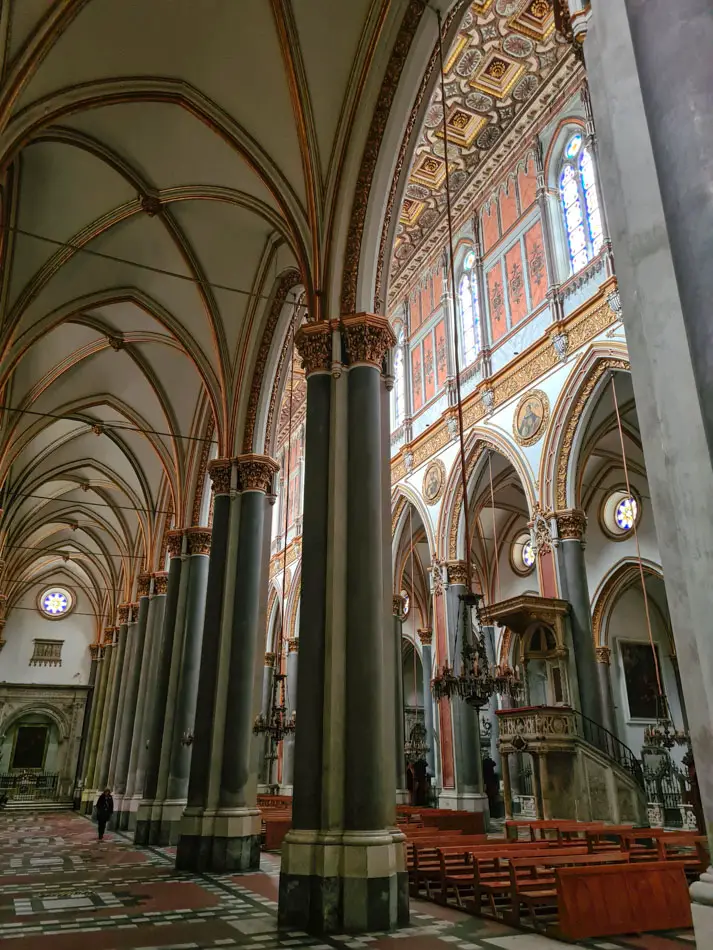
It looks very simple from the outside, but once inside, you realise it’s really impressive. The ceiling is magnificent as are the pillars, stained glass and altar, and all sculptures and decorations. This place is a true gem in the city, so, don’t forget to add it in your 2 days Naples itinerary.
Church of Gesù Nuovo (Chiesa di Gesù Nuovo)
Gesù Nuovo (the New Jesus) is a beautiful ornate church, located outside the western boundary of the historic center of the city. It is considered one of the most important churches in Naples.
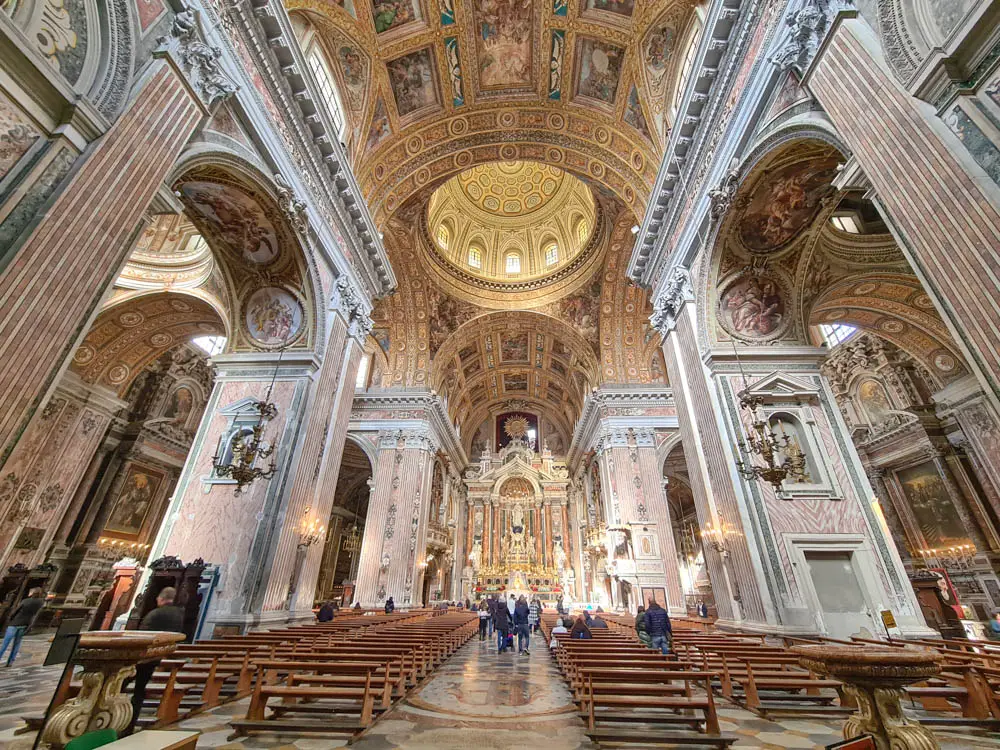
Gesu Nuovo was originally constructed in 1470 as a palace, but it was sold to the Jesuits at the end of the 16th century, who had it completely rebuilt. It has a very unusual facade studded with stone, diamond-shaped protrusions. However, the interior of the church of Gesù Nuovo is completely different look of Neapolitan Baroque architecture. It has many beautiful Baroque paintings and frescoes especially on the ceiling. Every part of the church is elaborately decorated with bright marbles that are dotted with beautiful marble statues.
It’s free to go inside, but be aware that there are several hours in the afternoon when the church is closed. It is open from 9 am to 12:30 pm and from 5 pm to 7:30 pm.
Santa Chiara Monastery Complex (Complesso Monumentale di Santa Chiara)
When exploring Naples for just 2 days, make sure to visit the Santa Chiara Monastery Complex. The complex is a little peace of heaven in Naples. It was founded in the 14th century in the historic center of the city. The complex includes several structures, but the one that is certainly most impressive is the vividly decorated cloister (chiostro). The picturesque cloister gardens is by far the main attraction of the complex with colourful decorated pillars in ornate hand-painted majolica tiles, added in 1742 by Domenico Antonio Vaccaro in Rococò style. Tile benches connect the pillars, depicting scenes from everyday life from that period.
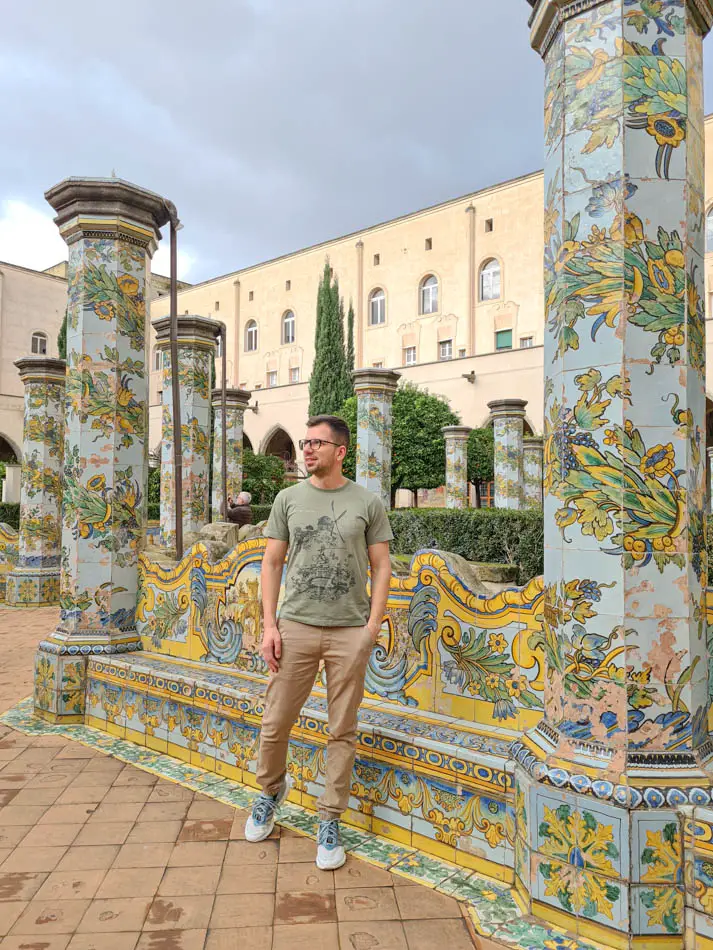
There is an exhibition in the museum which is also very good with some interesting relics and an amazing archeological site with ancient Roman bath ruins. The visit will take half an hour at least, though, you can easily spend longer.
Castel Nuovo (Maschio Angioino)
Castel Nuovo, also known as Maschio Angioino, is a medieval castle located in front of Piazza Municipio and the city hall (Palazzo San Giacomo) in Naples. It was built between 1279 and 1282 by King Charles I of Anjou, who ascended to the throne of Sicily and moved the capital from Palermo to Naples. In 1443 it was rebuilt by Alfonso V of Aragon, who had conquered the throne of Naples. From here is the distinguished Medieval Renaissance style of the fortress that remains to this day. One of the main attractions is the impressive main gate in a triumphal arch shape.
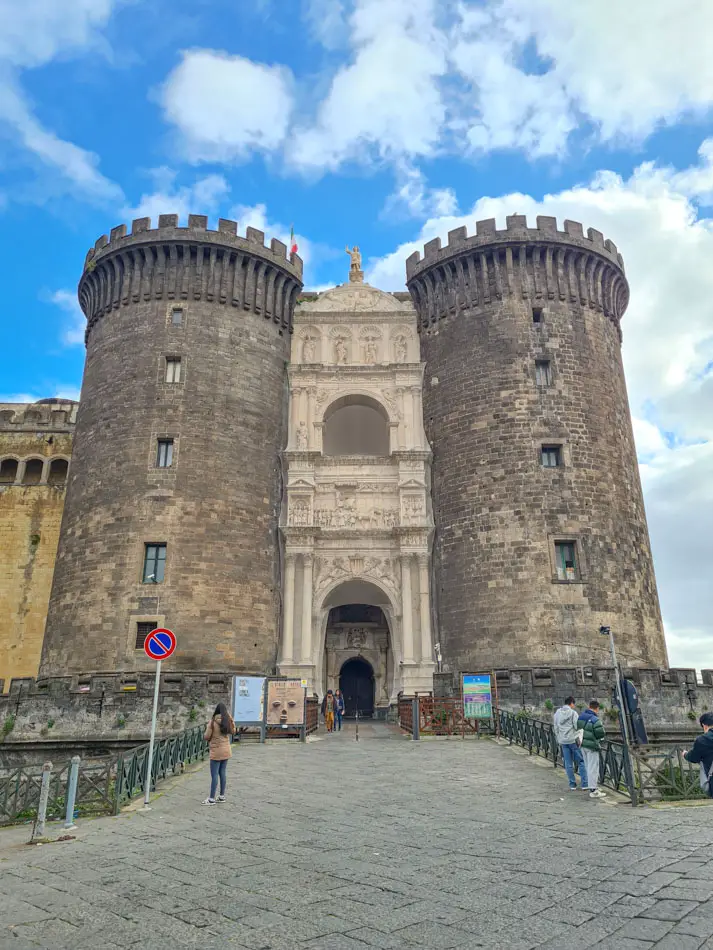
The admission fee is €6, but it includes only the museum (Museo di Castel Nuovo ) and Chapel. For an extra €10 you can visit the rest of the castle taking a guided tour.
Galleria Umberto I
Galleria Umberto I is a magnificent building located near the Piazza del Plebiscito. It is a shopping gallery, very similar to Milan’s Galleria Vittorio Emanuele II. It was built in 1890 and it was named after King Umberto, the king of Italy at that time. It was constructed following the unification of Italy as part of the Risanamento di Napoli (the rebuilding of Naples).
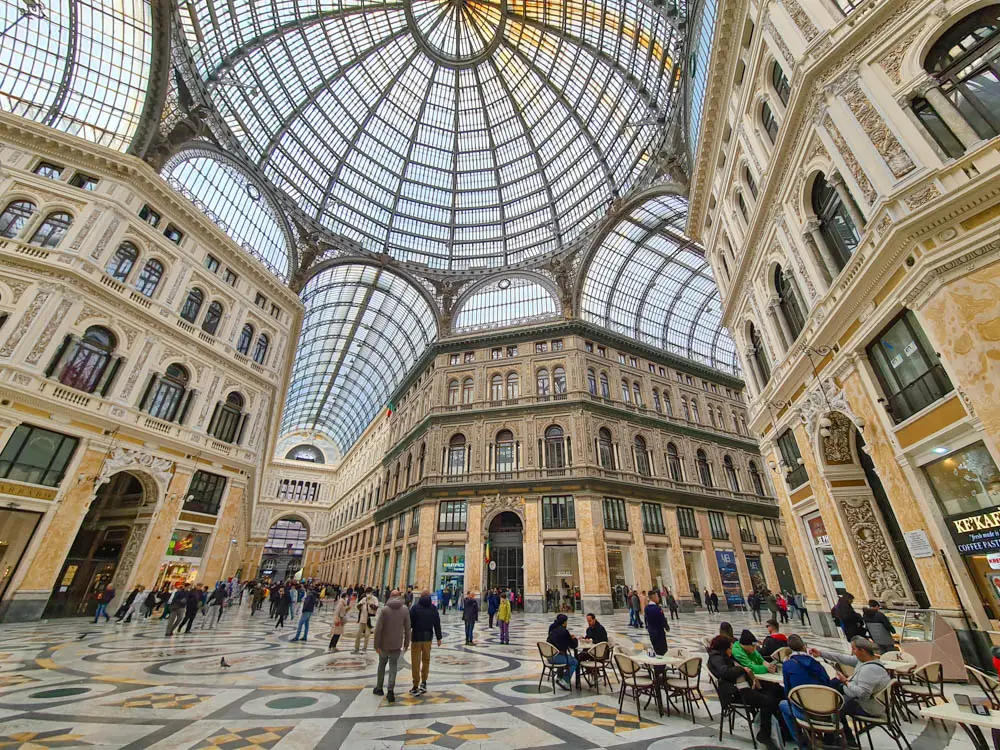
You’ll be absolutely amazed by the spacious cross-shaped structure, incredible glass-domed ceiling and the mosaics. There are four entrances and plenty of shopping places, along with cafés and restaurants.
San Carlo Theatre (Teatro di San Carlo)
Teatro di San Carlo in Naples is the world’s oldest working opera house. It is connected to the Royal Palace next to the Piazza del Plebiscito. Opened in 1737 under the rule of King Charles VII of Bourbon (Carlo VII in Italian), the opera house still bears the grandeur of the time. The lavish interior is really impressive with gorgeous gold baroque trim, red curtains and seats, and stunning ceiling paintings.
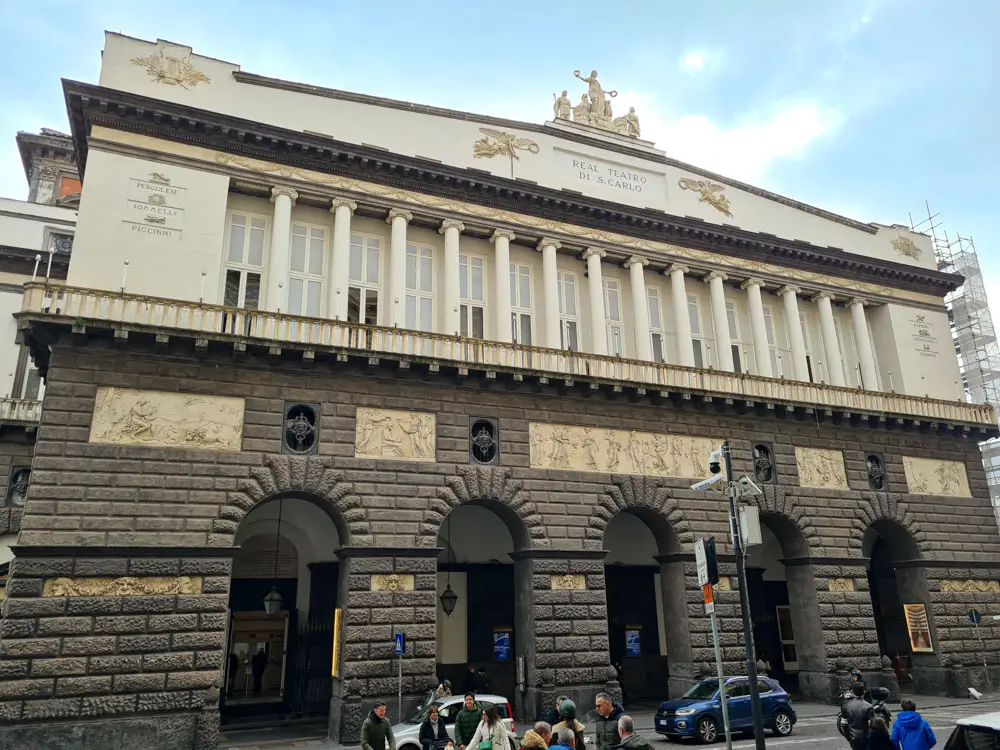
You can only visit it if you attend a performance or book a guided tour. The tours last 45 minutes and include the main stage hall, royal box, and foyer.
Gran Caffè Gambrinus
Just a stone’s throw from the square is located the famous Gran Caffè Gambrinus, founded in 1860. It is very historic cafe known for being a meeting site for intellectuals, artists, writers, musicians, et cetera. The decor and artwork are amazing inside, but that’s all. It is very overrated and I don’t recommend it.
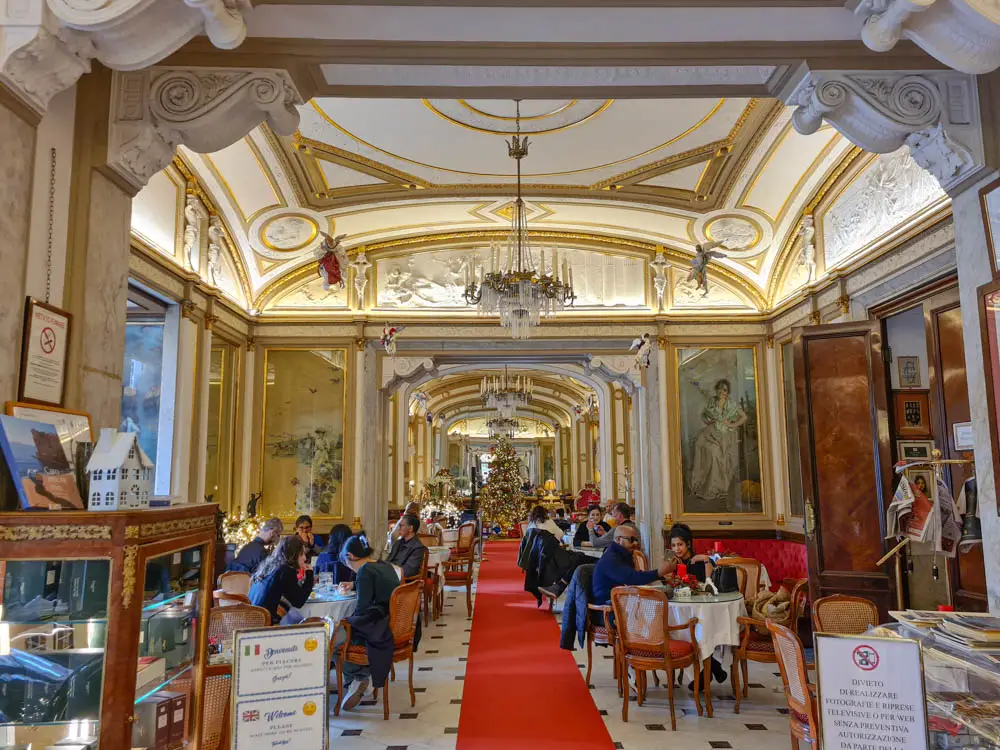
Piazza del Plebiscito
Piazza del Plebiscito must be included in every Naples Itinerary in 2 days. It is the largest square in the city, home to the impressive Royal Palace of Naples, Palazzo Salerno, the Basilica of San Francesco di Paola, and the Prefecture Palace (Palazzo della Prefettura). Moreover, the are two equestrian statues depicting Ferdinand I and Charles III. This huge square feels so reminiscent of that in Vatican City. On the other hand, the architecture of San Francesco di Paola Church reminds to the Pantheon in Rome.
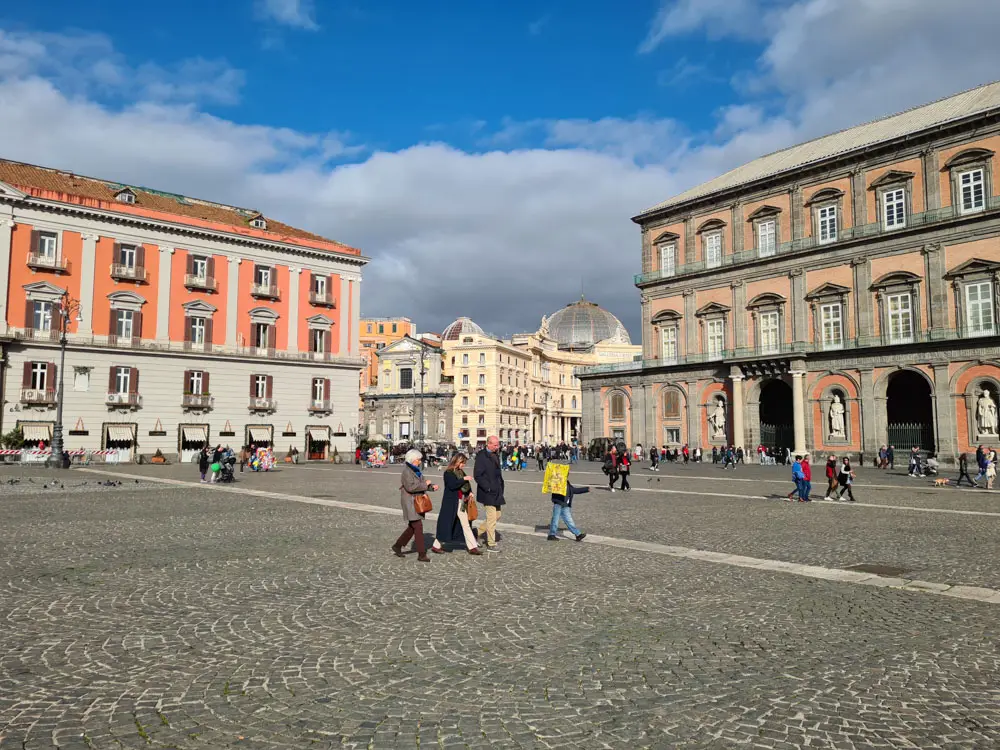
Today, Piazza del Plebiscito is a popular meeting place and it is also used for open air concerts and various other events.
Royal Palace of Naples (Palazzo Reale di Napoli)
The Royal Palace of Naples is one of the most recognised landmarks in Naples. Once used to be a residence to the Bourbon family during their rule of the Kingdom of Naples, today it is one of the most representative museum complex in Naples. But before Bourbon dynasty, it was intended to house King Philip III of Spain during his visit to Naples.
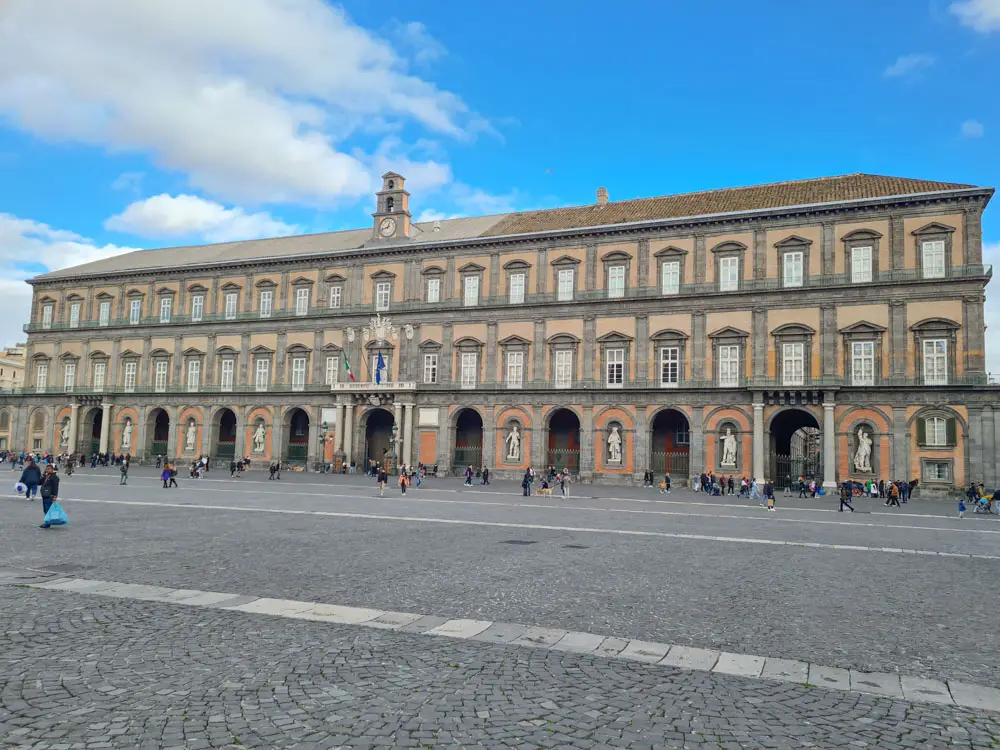
The main facade of the palace (fronting on Piazza del Plebiscito) shows a series of statues of prominent rulers of Naples in chronological order throughout history. However, inside the palace you will enjoy the gorgeous marble staircase, known as the Scalone d’Onore (Staircase of Honor), which leads to the many lavishly decorated rooms. The Royal Palace hosts over 30 glamorous royal rooms representing the extravagant lifestyle of the royal families, including the National Library and the nearby San Carlo Theater (Teatro di San Carlo).
Basilica of San Francesco di Paola
The Basilica of San Francesco di Paola is a stunning neoclassical building with 53 meters high dome located to the west in Piazza del Plebiscito.
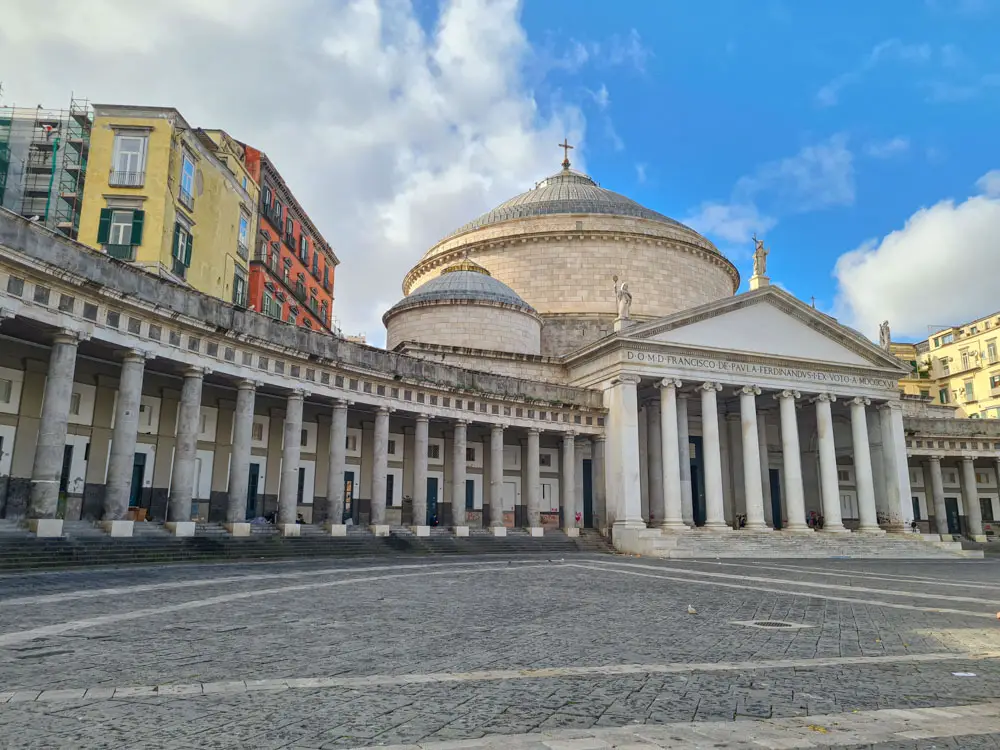
This very imposing basilica contains a number of statues, colonnades, and a columned portico. The church is reminiscent of the Pantheon’s circular basilica in Rome, while the triangular shaped portico with columns and pillars imitates Saint Peter’s Basilica in Vatican.
Castel dell’Ovo
Castel dell’Ovo (Egg Castle in English) is the oldest remaining fortification in Naples, built in the early 6th century BC. Its name is linked to the legend that the Roman poet Virgil placed an egg in the foundation of the castle. If the egg ever broken, the castle would have been destroyed, together with the city of Naples.
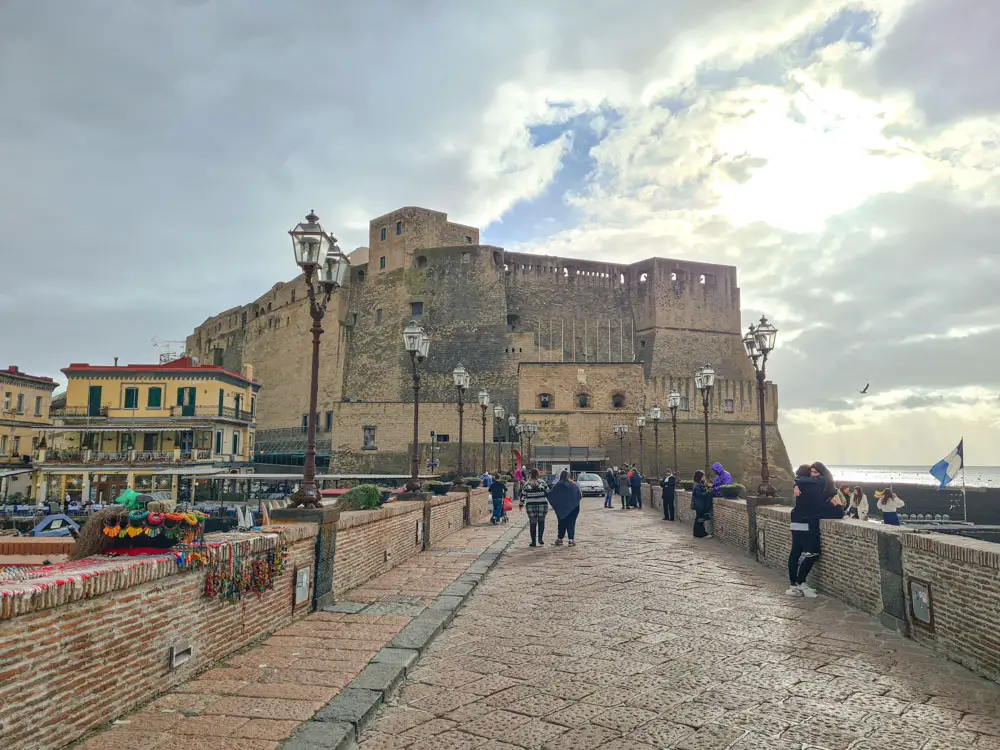
Once part of an island called Megaride, now a peninsula, connected to the mainland and is accessible by a footpath and road. The castle is open to the public for free, so, don’t miss it when in Naples. Honestly, there is not much to do and see there, so its just a walk around too see different views of the Gulf of Naples.
Stroll along Lungomare Caracciolo
The Lungomare Caracciolo is a beautiful seafront promenade in Naples, Italy. It starts at Via Acton and then crosses many areas, including the Riviera di Chiaia known for shopping and nightlife. Finally, you have the ascent towards Posillipo district, which a higher part of the city. However, one of the main attractions of the Lungomare Caracciolo promenade is the sea views with Mount Vesuvius in the background and the Castel dell’Ovo. It is very pleasant for a walk in the evening or in the morning. At one of the many restaurants you can sit down and have a drink or nice meal.
Fontana del Gigante
The Fontana del Gigante, also known as the Fountain of Immacoletella (Fontana dell Immacoletella), is located along Lungomare Caracciolo. The monument is an exquisite work of Mannerist, designed in the 17th century. It is lavishly decorated with three arches above which are placed heraldic symbols.
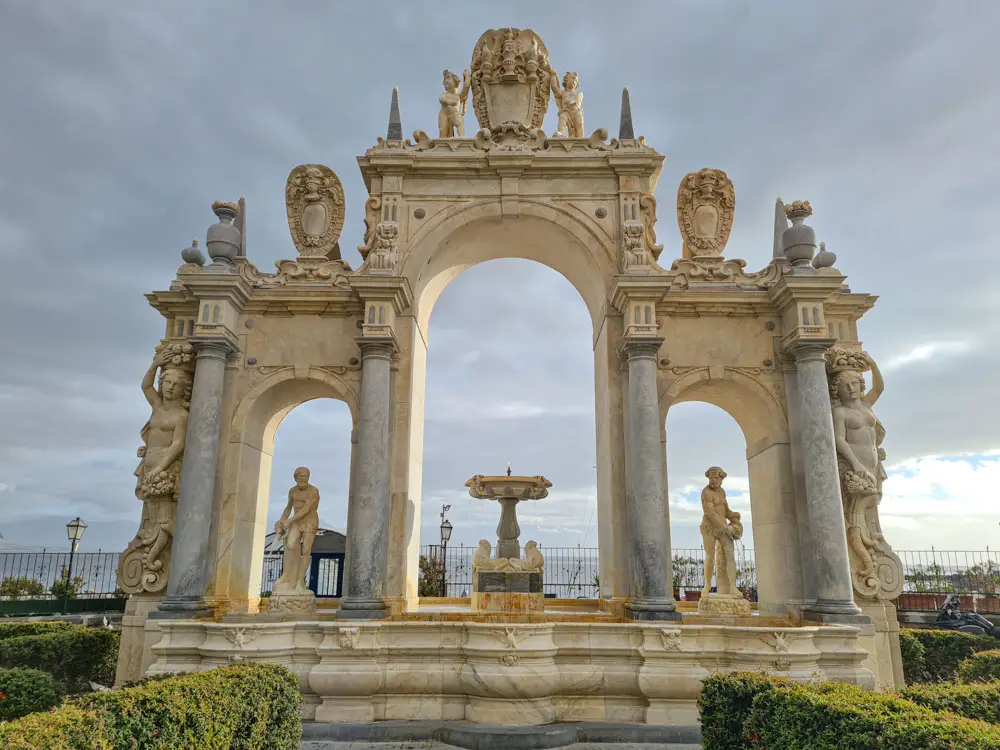
Via Toledo
Via Toledo is the most important commercial street in Naples, home to a number of public and religious buildings, shops, boutiques, cafes, etc. It is about 1.2 kilometers and it stretches from Piazza Dante to Piazza Trieste e Trento. This historic street dates back to 1536, when it was created by order of the Spanish Viceroy Pedro de Toledo.
Toledo Metro Station
After exploring the historic sightseeings of Naples, what better way to return to your hotel than to take the metro. The Art Stations project (Stazioni dell’Arte) in Naples showed that metro stations in the city can be true masterpieces of art. A group of contemporary artists and architects changed the vision of the metro stations, turning them into an open-air museum. The dazzling Toledo metro station is considered as one of the most beautiful metro stations in the world. Don’t miss the other metro stations along line 1 (Linea 1), when in Naples.
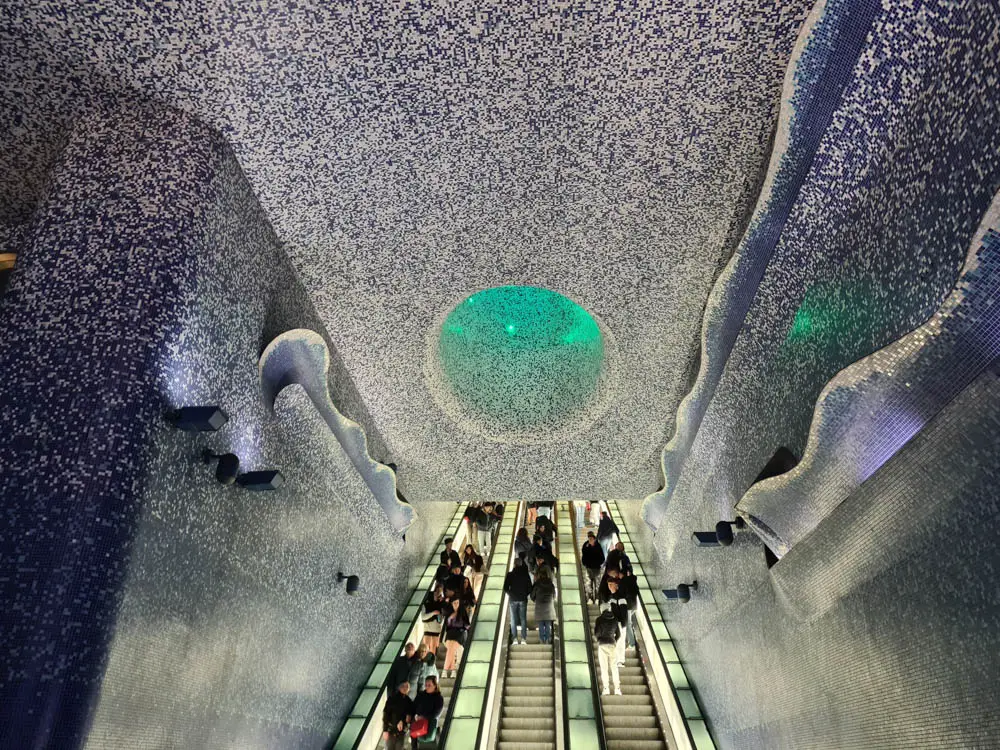
Quartieri Spagnoli
Quartieri Spagnoli is one of the most authentic areas in Naples. It literally means Spanish Quarters and it is located next to the Via Toledo, one of the largest shopping streets in Naples. The area was created in the 16th century to house Spanish troops during the Spanish rule. Through the years, the area was known with lot of violence, crime, and drugs, where the Camorra or criminal organizations operate. Today is a completely different story…
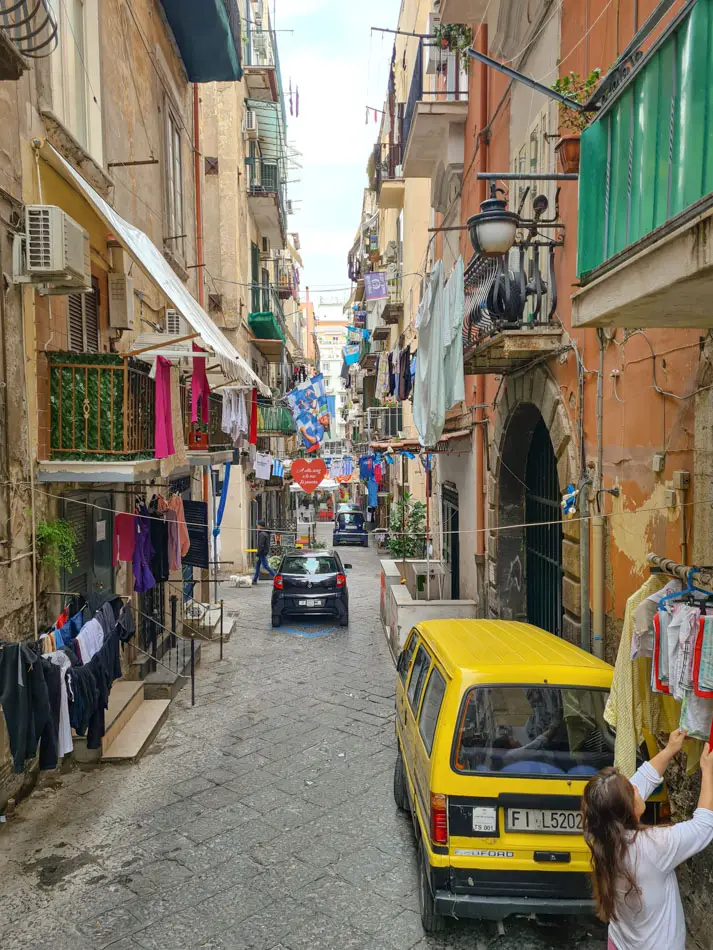
As it is one of the city’s most densely populated areas, this neighborhood always seems to be busy, chaotic and loud. The rushing scooters, the steep narrow streets, the hustle and bustle, the people chatting, the coffee shops and the restaurants often packed with people, washing strung between the upper stories, make this place absolutely must visit in your 2 days in Naples Itinerary.
But that is not the end – here, you can find the world-famous mural of Diego Armando Maradona located in Via Emanuele de Deo.
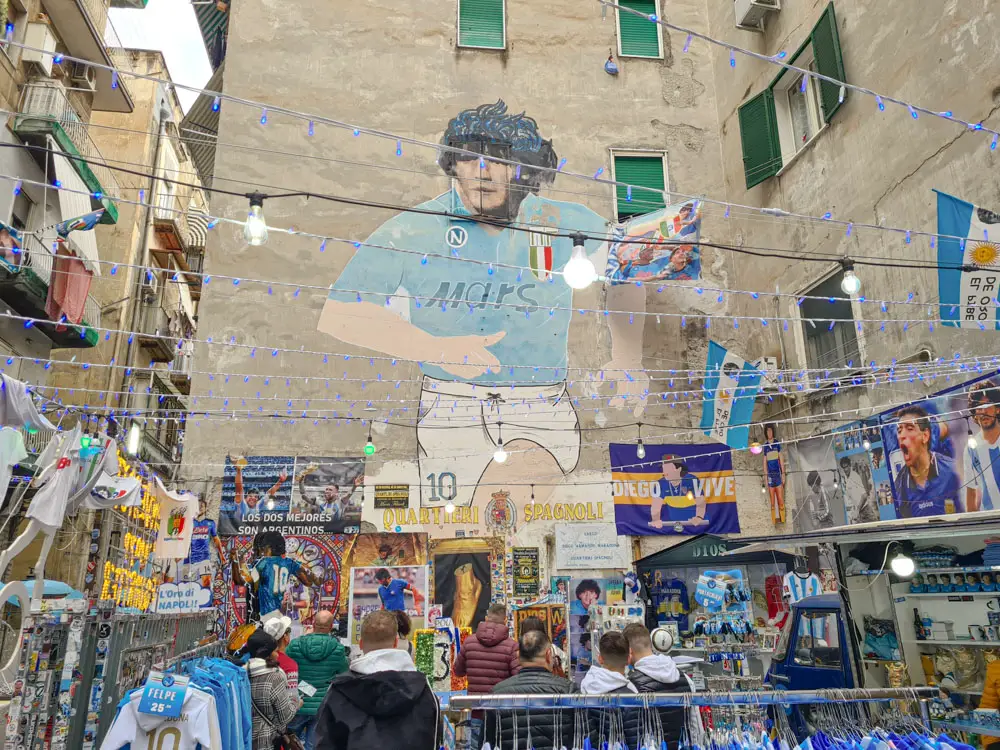
Castle Sant’Elmo (Castel Sant’Elmo)
If you want to see Naples from above, then you should visit Castle Sant’Elmo. It is located at the top of Vomero hill and offers stunning panoramic views across the Bay of Naples, the historic center, and the Mount Vesuvius on the horizon.
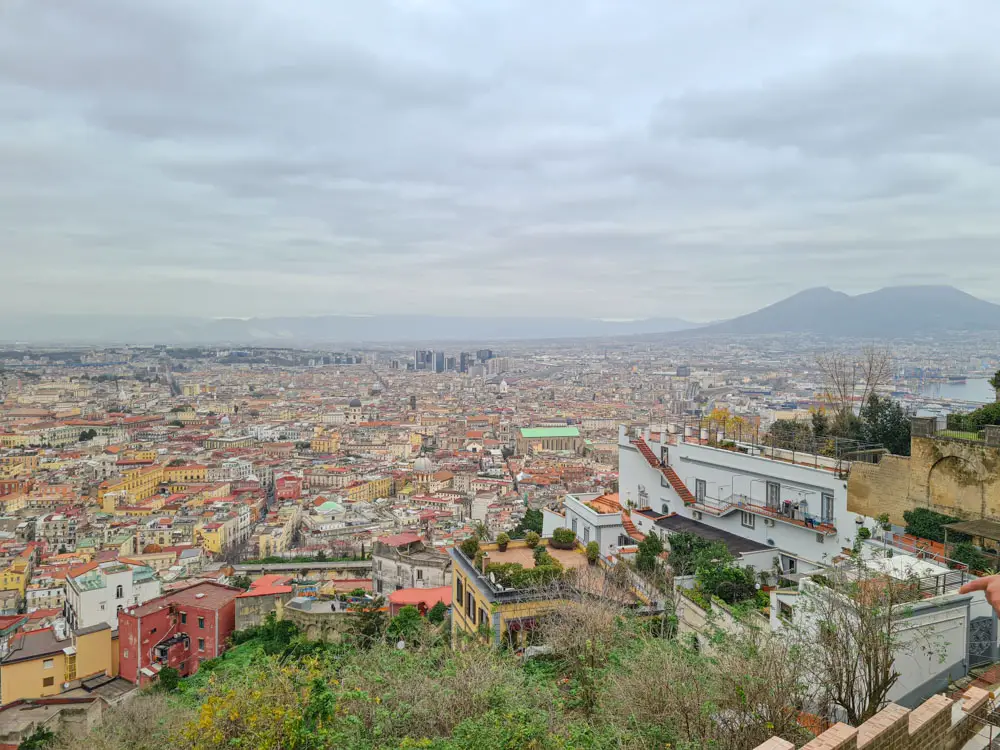
The best way to get to the Castle Sant’Elmo is by funicular. There are three funiculars that ascend Vomero Hill of which the Funicolare di Montesanto drops you off at the top of the mountain at the stop “Morghen”. It is about a 5 minute walk to the entrance of the fortress. I highly recommend taking the funicular up and walking on foot on your way down.
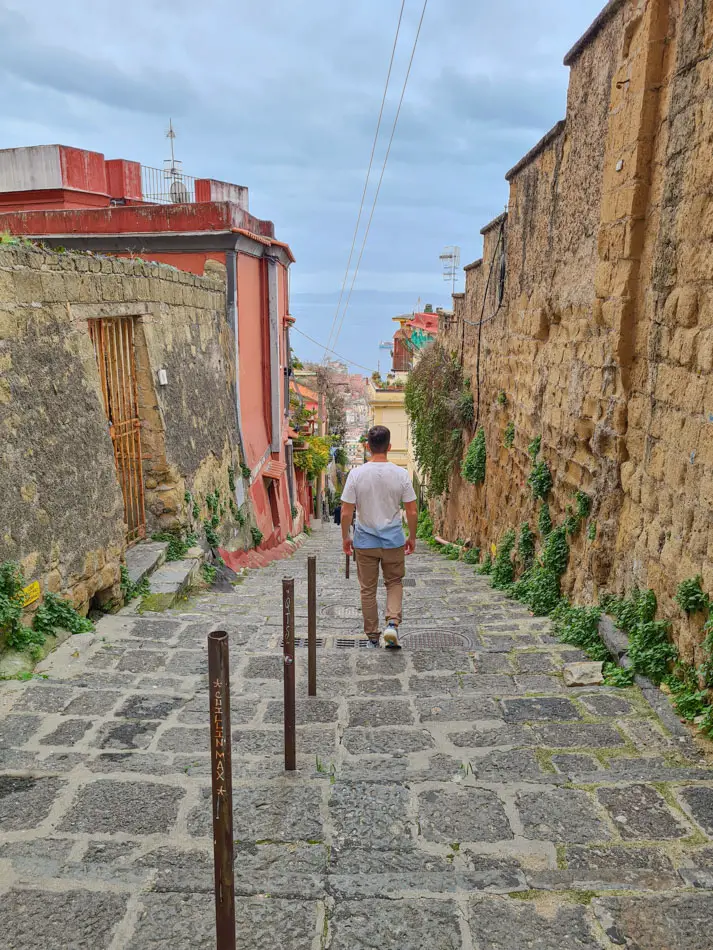
In addition to the stunning views, you can explore the castle and its hexagonal star-shaped fortress. Castel Sant’ Elmo was built in the 13th century, but it was heavily rebuilt to the current fortress in later centuries.
Naples National Archaeological Museum
If you are interested in archeology this is your place. The building was originally built to host the royal cavalry barracks at the end of the 16th century. From 1616 to 1777 it was the seat of the University of Naples. When the University was moved elsewhere, it became a museum, known as Real Museo Borbonico (the Royal Bourbon Museum). After the unification of Italy it was renamed National Museum.
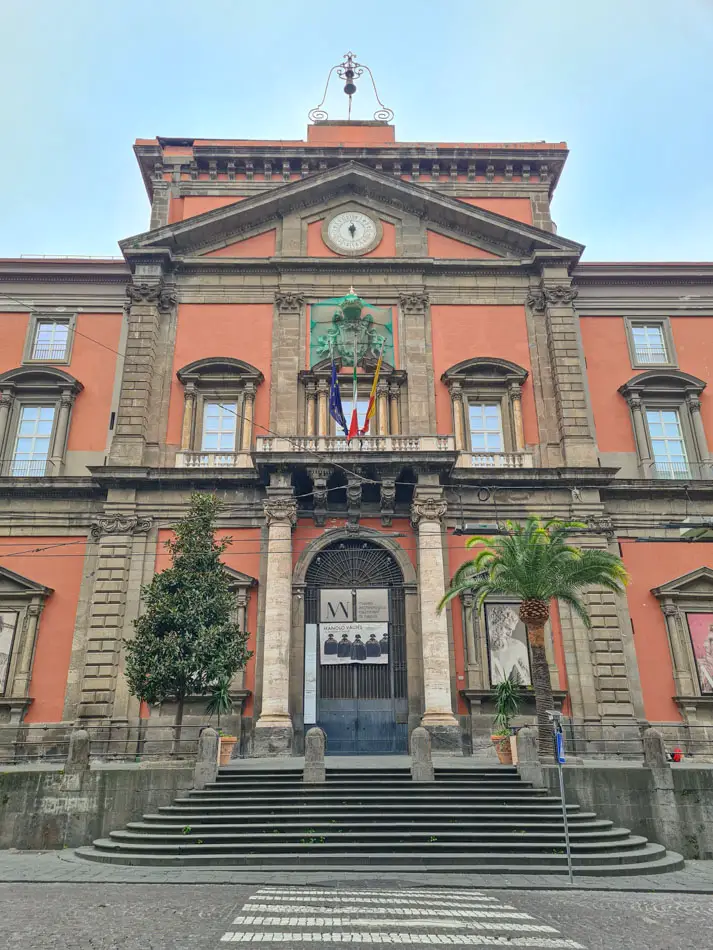
The Naples National Archaeological Museum is undoubtedly a must-visit place. It is considered as one of the best museums in the world of its kind. It is famous for its great remains from Antiquity and it has an amazing collection of Greek and Roman artifacts, and relics from Pompeii and Herculaneum. The collection includes marble statues and sculptures depicting scenes from ancient mythology, beautiful mosaics, different frescoes, ceramics, erotica, large coin collection, and Egyptian collection etc.
Catacombs of San Gennaro (Catacombe di San Gennaro)
The Catacombs of San Gennaro are underground paleo-Christian burial and worship sites in Naples. They were probably the tombs of a noble family, carved out of the tuff and later available to the Christian community. The catacombs are comprised of two levels, the lower from 2nd century AD, followed by the upper expansion in the 4th century AD. The upper space is also known as the burial place of the bishops. There is no option to visit the Catacombs of San Gennaro on your own and visits must be done with a guide. They only have groups in Italian and English. I highly recommend to book on-line ticket in advance.
The catacombs are open for visits every day from 10 am to 5 pm. They are right next to the Basilica of the Madre del Buon Consiglio and about 15 minutes’ walk from the Capodimonte Palace.
National Museum of Capodimonte (Museo di Capodimonte)
The Royal Palace of Capodimonte was a former summer residence and hunting lodge of the Bourbon’s family. It is located in the hill above the city and it is surrounded by a beautiful public park. Today, the Royal Palace houses the Naples Museum of Art.
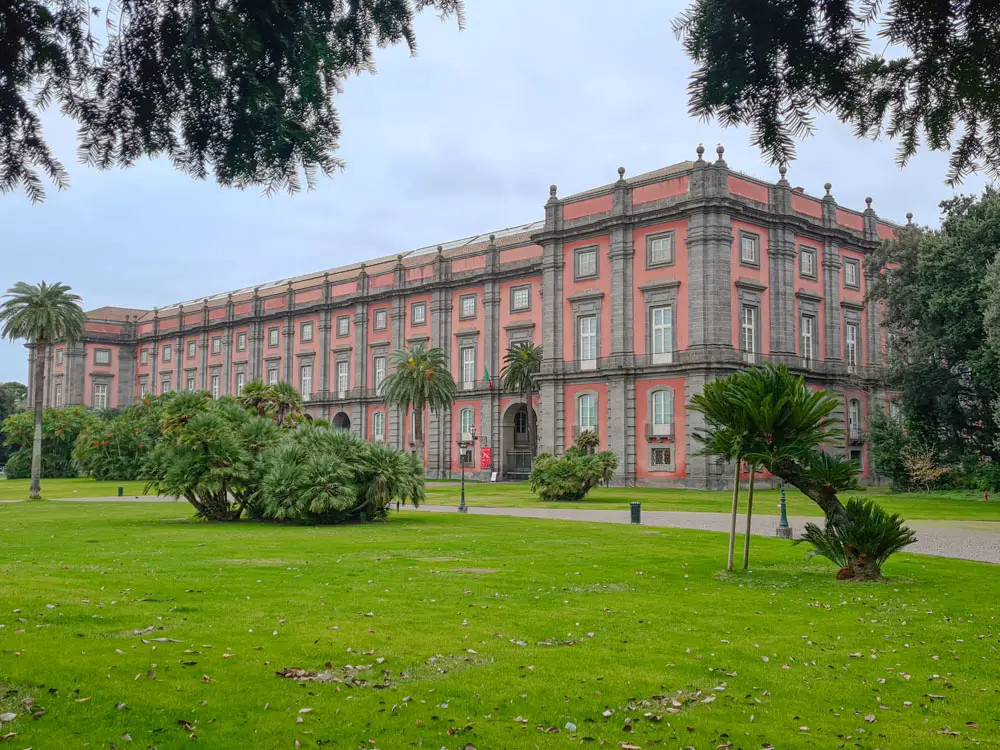
The museum displays a vast collection with paintings from the 13th to the 18th centuries by Raphael, Masaccio, Titian, El Greco, Giovanni Bellini, etc. Here, you will see the stunning masterpiece “The Flagellation of Christ” by Caravaggio, which is not to be missed.
Naples Underground (Napoli Sotterranea)
Visiting Naples Underground is definitely one of the best things to do in your 2 days in Naples Itinerary. It is one of the most popular attractions in Naples and a fascinating glimpse into the history of Naples. There is a network of tunnels, squares, chambers, aqueducts, and passageways built by the Greeks and Romans and which were later used as bomb shelters during World War II.
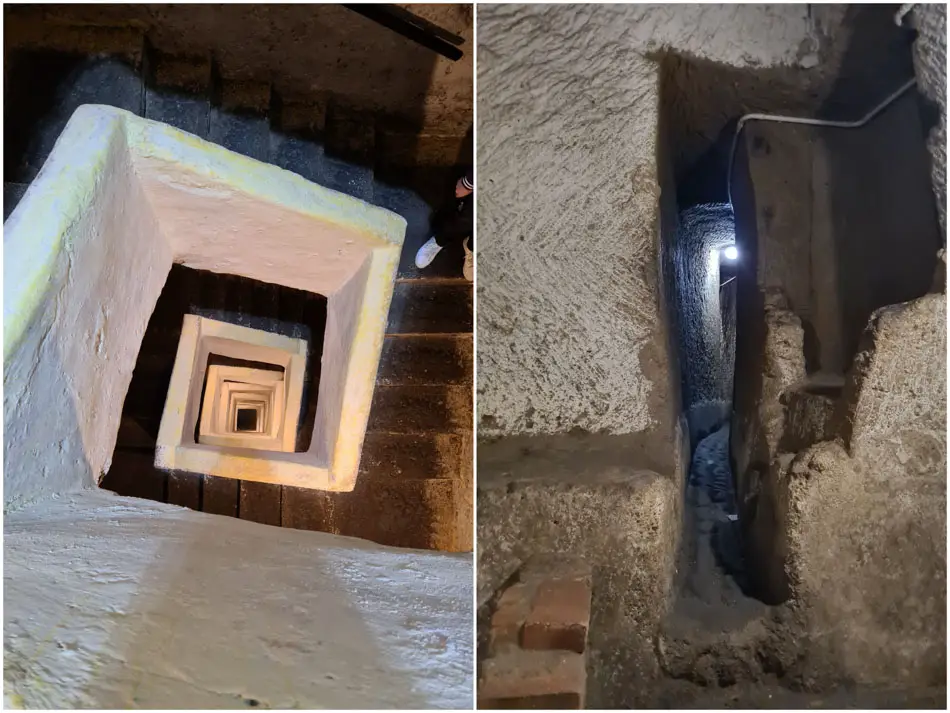
The ancient Greeks were the first to dig tuff to build Neapolis (ancient Naples), leaving behind caverns and tunnels. When the Romans came along, they continue using existing tunnels as aqueducts to supply the city with water. During World War II those secret tunnels served as bomb shelters, where more than 200,000 citizens were hiding from bombings.
Nowadays, you can join many interesting underground tours in Naples, only possible to visit on a guided tour. There are several different guided underground tours: Napoli Sotterranea, Galleria Borbonica (Bourbon Tunnel) and La Neapolis Sotterrata (San Lorenzo Maggiore). Each of the underground tours is different and interesting in its own way.
The Napoli Sotterranea is the most popular of all routes, where you can admire the Greek Roman Aqueduct, the Roman theater and the Summa Cavea.
Galleria Borbonica, or the Bourbon Tunnel, is another stunning part of the Naples underground network. The tunnel was created in the 19th century by Ferdinand II Bourbon and stretches from the Royal Palace to Piazza Vittoria near the seafront. It was constructed to provide the king an escape route in case of an uprising. During the war the tunnel served as an air raid shelter for the people. Today, you can see fragments of huge statues alongside antique cars and motorcycles buried under the debris.
Beneath the Basilica of San Lorenzo Maggiore hide remains of the Greek and Roman city of Neapolis. The ancient La Neapolis Sotterrata was originally founded by the ancient Greeks in the year 470 BC. It was the geographic center of the ancient Greek-Roman city of Naples, place that housed the agora and later Roman Forum.
Pompeii Archeological Site (Parco Archeologico di Pompei)
Naples is the best place for visiting the ancient city of Pompeii. It was located near the volcano of Mount Vesuvius, but in AD 79, the volcano erupted, covered the entire city along with thousands of its inhabitants under volcanic ash. However, the volcano is still active, so there’s always risk of another eruption. Pompeii is one of the main landmarks not only in Naples, but in Italy. It is a UNESCO World Heritage Site, home to the world’s oldest amphitheater, the Pompeii Amphitheater. In addition to that, there are many interesting sights as the Temple of Jupiter, the Temple of Apollo, the Temple of Vespasian, the Temple of Isis, the Stabian Baths, the House of Menander, and many more.
Today, you can easily visit the remains of the ancient city as a day trip from Naples. The best way to get to Pompeii from Naples is by the local train, called the Circumvesuviana. The closest station to the famous ruins of the Ancient Roman city of Pompeii is Pompei Scavi – Villa Dei Misteri. I highly recommend to buy your tickets in advance, it allows you to skip the queue to get inside.
Herculaneum
Herculaneum was another ancient Roman town, buried under volcanic ash and pumice after the 79 AD eruption of Vesuvius. It was also affected by the volcanic eruption, but is better preserved than Pompeii. The volcanic ash of Vesuvius acted like a shell, preserving the houses, public baths, temples, statues, mosaics, etc. This fascinating archaeological site is a lot smaller, easier to explore, and less crowded than Pompeii. The city of Herculaneum, known as Ercolano in Italian, is a UNESCO World Heritage Site, and it was known for being much wealthier than other towns in the area.
You can get to Herculaneum by Circumvesuviana train from the Naples Garibaldi train station. The journey takes about 15 minutes. You get off at the train station Ercolano Scavi, and then is only a 10 minute walking to the entrance of the park.
Climbing Mount Vesuvius (Vesuvio)
One of the best day trips from Naples is to Mount Vesuvius. It rises 1,281 meters above sea level and is the only active volcano in continental Europe. However, you can climb the mount on your own or with a guide on an organised excursion. The best way to visit Mount Vesuvius is together with Herculaneum. From the station there are shuttle buses – Vesuvio Express, which will take you to the entrance of the park. Then you continue on foot for about 15-20 minutes to the top.
Where and what to eat in Naples?
Antiqua Pizzeria Port’Alba
Naples is the birthplace of pizza, so there’s no better place to taste an authentic Neapolitan pizza. There are plenty of pizzerias in the city, but one of them deserves more attention. Antiqua Pizzeria Port’Alba is the oldest in the world, located in the city’s historic center.
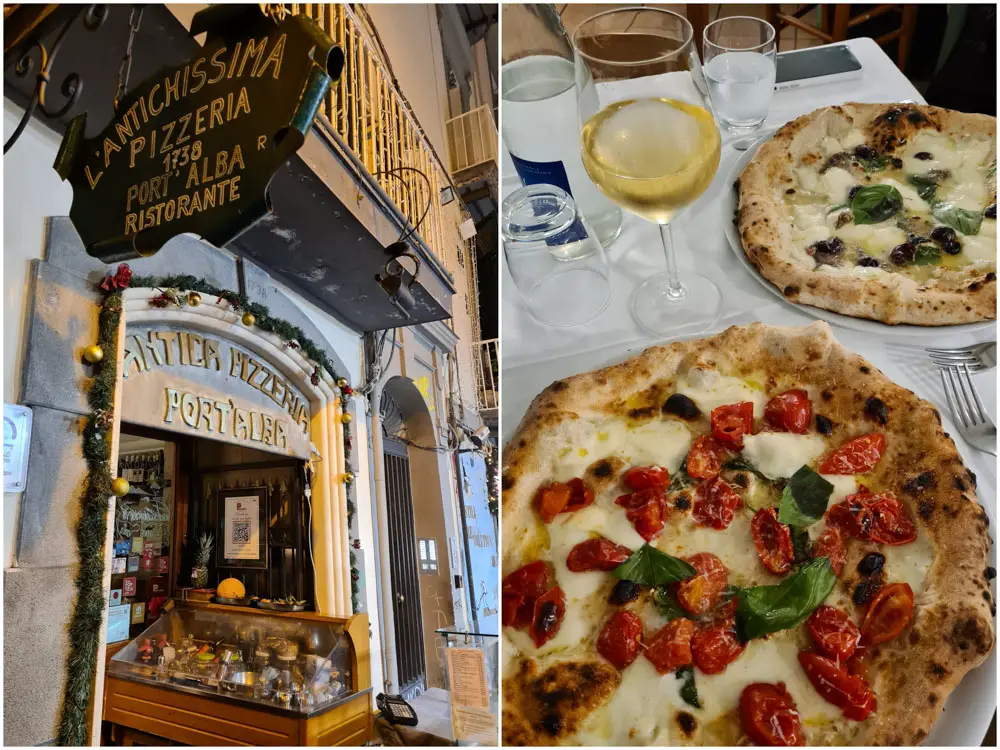
Officially, it was opened in 1830, but the origins dates back to 1738 when street vendors who made pizza in ovens lined with volcanic rocks from the nearby volcano of Vesuvius.
L’antica Pizzeria da Michele
L’antica Pizzeria da Michele is one of the most popular places in Naples. You will be able to try only 4 types of authentic Neapolitan pizza – Margherita, Marinara, Kosaka and Marita, which is a mix between Margherita and Marinara. Curiously, this is where Julia Roberts eats pizza in the movie “Eat, Pray, Love”.
Antica Pizza Fritta da Zia Esterina Sorbillo
You can’t go to Naples without trying the delicious Neapolitan fried pizza at Auntie Esterina Sorbillo’s. There are several types with different flavors, but the menu is only in Italian. Note that this is one of the most popular fried pizza places in Naples.
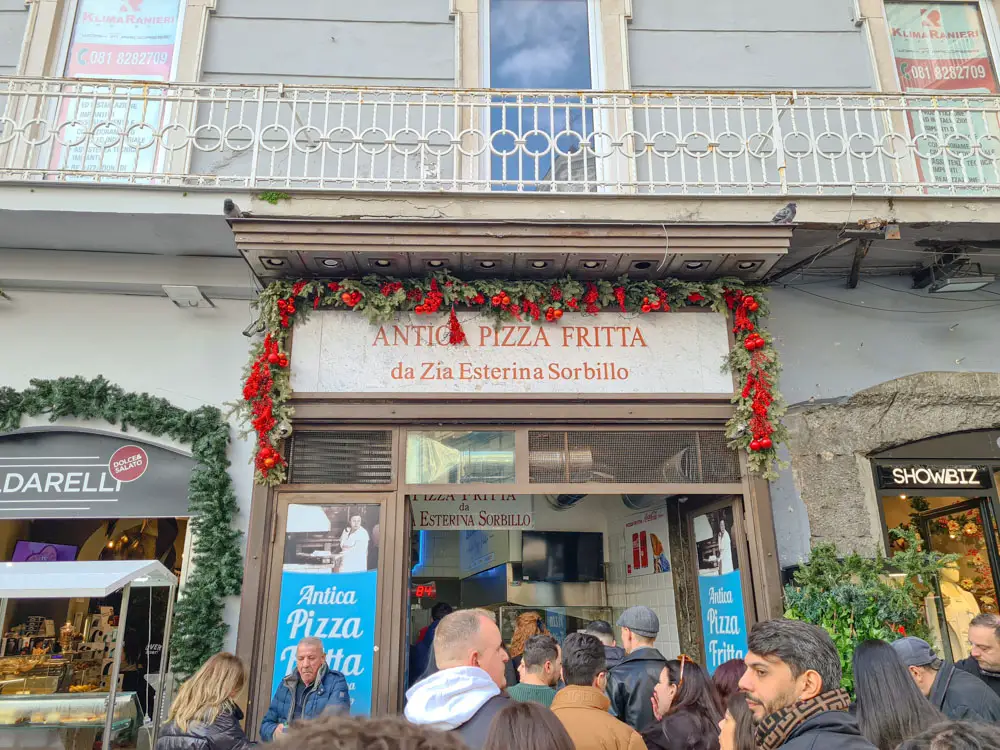
Sfogliatella
The sfogliatella is a symbol of the city of Naples and the most typical dessert. It is a shell-shaped filled Italian pastry originating from Campania. It is usually served at breakfast.
Neapolitan rum babà
Neapolitan rum babà is one of the symbols of Neapolitan cuisine. It is a dessert soaked in a sticky, citrus-scented boozy syrup, and it is also found with chocolate, cream or fruit. One of the best places where you can try delicious and authentic babà is at Pasticceria Scaturchio, dating back to 1905.
Where to stay in Naples?
The best areas to stay in Naples are Centro Storico, Piazza del Plebiscito, Chiaia, and Vomero. During my trip to Naples, I stayed right in the historic city centre (Centro Storico) in a B&B place, called Domus San Biagio 14, This part of the city is very safe and here you will find the city’s main tourist attractions. It is the best choice for first time travelers in Naples.
Piazza del Plebiscito is one of the most iconic squares in Naples. It is a great place to stay for families because it is very centrally-based and quieter than other touristic areas. It offers easy access to the Royal Palace and the San Carlo Theater, as well as Via Toledo and Galleria Umberto I.
Chiaia is one of the safest areas in Naples, a bit further from the center. It is a famous upscale neighbourhood known for its elegant shops, boutiques and restaurants.
Cheap flight tickets to Naples
Low Cost Airlines WizzAir and RyanAir operate regular flights to/from Capodichino Airport. During the low tourist season, you can often find cheap flight tickets to Naples, as well as domestic flights from Turin, Milan, Bergamo, Catania, Rome and others. You can take a flight from Bologna too, but it is not direct and I don’t recommend it. Naples is also easily accessible by train. There are numerous trains from the capital Rome throughout the day.
Best time to visit Naples
The best time to visit Naples is between March and May or September and October, when the weather is mild. During these months the temperatures are around 20-25°C. It is the perfect time to explore the city’s famous landmarks, while avoiding the tourist crowds and heat of the summer months (July and August).
How many days to stay in Naples?
In this 2 days in Naples Itinerary you will be able to visit only the best places in the city. You won’t have enough time to explore some of the landmarks outside Naples. That’s why I recommend spending at least four days in Naples. This will give you enough time to enjoy the city and the surrounding area.
Is Naples safe for tourists?
I think Naples is much safer than people think. Well, it is not the safest city in Italy, so you should pay extra attention while in Naples. The most common crime in Naples is pickpocketing and distracted tourists are often the targets. I advise you not to wear valuable items such as watches or jewels. However, as long as you’re the in tourist areas, you will likely feel secure.
Is Naples worth visiting?
Yes, Naples is absolutely worth visiting. It has a history that stretches back more than 2,000 years, being one of the oldest continuously inhabited urban areas in the world. With its archeological sites, fascinating history, stunning palaces, the volcano Vesuvius, the crystal blue waters of the Gulf of Naples, delicious cuisine and more, Naples is truly worth a visit from any kind of traveler.
Disclaimer: This post may contain affiliate links. If you make a purchase or booking through one of our links I may earn a small commission (don’t worry, it’s at no extra cost to you).
